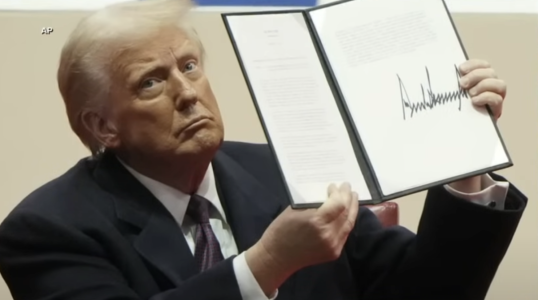A shift in policy? Trump’s executive order sparks new conversation on civil rights enforcement
By
Veronica E.
- Replies 5
The Civil Rights Act of 1964 has long stood as a landmark in American law, prohibiting discrimination in education, employment, housing, and public accommodations.
Over the decades, it has helped expand access and protections for many individuals across the country.
A new executive order signed by President Donald Trump on April 23 has reignited conversations over how the law is enforced—and what “equality” should look like today.
The executive order aims to modify how parts of the Civil Rights Act are applied, emphasizing “equality of opportunity, not equal outcomes."
The order outlines a policy approach that treats individuals as unique, rather than as members of racial or identity groups.
"It promises that people are treated as individuals, not components of a particular race or group. It encourages meritocracy and a colorblind society, not race- or sex-based favoritism," the order states.
While presidents cannot repeal laws, legal experts note that executive orders can influence how agencies enforce them, which they said appears to be the primary effect of this directive.

A major point of focus in the order is disparate-impact liability—a legal concept that allows for challenges to policies that disproportionately affect certain groups, even if unintentional.
The Trump administration argues this approach violates the Constitution and “basic American ideals” by requiring consideration of race to avoid legal risk.
“It not only undermines our national values, but also runs contrary to equal protection under the law and, therefore, violates our Constitution," the order reads.
The order calls for federal agencies to “deprioritize enforcement” of regulations based on disparate impact.
It also directs a review of pending investigations and legal cases, and instructs the Attorney General to revise Title VI regulations related to this legal standard.
Trump said the order is meant to uphold the American dream, which he described as being challenged by “a pernicious movement” that promotes “a divisive pursuit of results preordained by irrelevant immutable characteristics, regardless of individual strengths, effort, or achievement."
Many legal experts believe the order is likely to face court challenges.
In the meantime, they say it may create uncertainty about legal protections and enforcement.
"It's sending a message to the nation that will undermine the rights of people of color," said Gloria J. Browne-Marshall, a constitutional law professor at John Jay College.
She added that the move could lead to confusion about individual rights and increase litigation.
The Civil Rights Act has been interpreted over time to protect not only against racial discrimination but also against bias based on gender, national origin, and religion.
Civil rights advocates note that it has opened up opportunities in public sector roles, including for women in fields like firefighting.
Barbara Arnwine, founder of Transformative Justice, highlighted that protections under the law have also benefited other groups. "Lots of people, including white men, had also been discriminated against in the workplace because of issues like short stature," she said.
Some advocates are concerned that efforts to scale back civil rights enforcement may overlook the law’s broader impact.
"That's something that people want to forget," Arnwine added.
Signed into law by President Lyndon B. Johnson in 1964, the Civil Rights Act aimed to dismantle segregation and promote equality across American society.
Its influence has extended into employment, education, housing, and federally funded programs, helping to build a legal framework for fair treatment and inclusion.
Although Republicans currently hold majorities in Congress, activists believe lawmakers are unlikely to push for changes to the Civil Rights Act itself, as any such attempt would likely meet strong public opposition.
"Congress created the laws and the US Supreme Court has supported their enforcement," said Browne-Marshall, who described the executive order as overreaching.
“From a legal standpoint, what the executive order was trying to do is beyond the boundaries and limits of that office."
She added that it remains to be seen whether the other branches of government will respond.
Fatima Goss Graves, president of the National Women’s Law Center, warned that if the Justice Department reduces its enforcement efforts, it could weaken civil rights protections overall.
“It’s been their long-standing roles to do that coordination and to bring those sorts of cases,” she said.
As the national conversation around civil rights enforcement continues, the full impact of this executive order is still unfolding.
What remains clear is that how these laws are interpreted and applied will continue to shape policy—and daily life—for many Americans.
Read next: Legal expert analyzes challenges facing Trump's executive orders

What are your thoughts on the future of civil rights enforcement? Should government policies focus more on individual opportunity—or continue to address patterns of unequal outcomes? Share your perspective in the comments!
Over the decades, it has helped expand access and protections for many individuals across the country.
A new executive order signed by President Donald Trump on April 23 has reignited conversations over how the law is enforced—and what “equality” should look like today.
The executive order aims to modify how parts of the Civil Rights Act are applied, emphasizing “equality of opportunity, not equal outcomes."
The order outlines a policy approach that treats individuals as unique, rather than as members of racial or identity groups.
"It promises that people are treated as individuals, not components of a particular race or group. It encourages meritocracy and a colorblind society, not race- or sex-based favoritism," the order states.
While presidents cannot repeal laws, legal experts note that executive orders can influence how agencies enforce them, which they said appears to be the primary effect of this directive.

President Donald Trump signed an executive order on April 23 addressing how aspects of the Civil Rights Act are enforced. Image Source: YouTube / ABC News.
Disparate-impact liability under review
A major point of focus in the order is disparate-impact liability—a legal concept that allows for challenges to policies that disproportionately affect certain groups, even if unintentional.
The Trump administration argues this approach violates the Constitution and “basic American ideals” by requiring consideration of race to avoid legal risk.
“It not only undermines our national values, but also runs contrary to equal protection under the law and, therefore, violates our Constitution," the order reads.
The order calls for federal agencies to “deprioritize enforcement” of regulations based on disparate impact.
It also directs a review of pending investigations and legal cases, and instructs the Attorney General to revise Title VI regulations related to this legal standard.
Trump said the order is meant to uphold the American dream, which he described as being challenged by “a pernicious movement” that promotes “a divisive pursuit of results preordained by irrelevant immutable characteristics, regardless of individual strengths, effort, or achievement."
Also read: The untold story of Nat King Cole’s role in the civil rights movement
Legal experts predictions
Many legal experts believe the order is likely to face court challenges.
In the meantime, they say it may create uncertainty about legal protections and enforcement.
"It's sending a message to the nation that will undermine the rights of people of color," said Gloria J. Browne-Marshall, a constitutional law professor at John Jay College.
She added that the move could lead to confusion about individual rights and increase litigation.
Also read: Internal fallout at USAID: Mass layoffs leave global staff reeling
Broader impact on civil rights protections
The Civil Rights Act has been interpreted over time to protect not only against racial discrimination but also against bias based on gender, national origin, and religion.
Civil rights advocates note that it has opened up opportunities in public sector roles, including for women in fields like firefighting.
Barbara Arnwine, founder of Transformative Justice, highlighted that protections under the law have also benefited other groups. "Lots of people, including white men, had also been discriminated against in the workplace because of issues like short stature," she said.
Some advocates are concerned that efforts to scale back civil rights enforcement may overlook the law’s broader impact.
"That's something that people want to forget," Arnwine added.
Also read: Upcoming laws set to impact you in 2025—prepare for change
Historical significance of the Civil Rights Act
Signed into law by President Lyndon B. Johnson in 1964, the Civil Rights Act aimed to dismantle segregation and promote equality across American society.
Its influence has extended into employment, education, housing, and federally funded programs, helping to build a legal framework for fair treatment and inclusion.
Legislative response and concerns about enforcement
Although Republicans currently hold majorities in Congress, activists believe lawmakers are unlikely to push for changes to the Civil Rights Act itself, as any such attempt would likely meet strong public opposition.
"Congress created the laws and the US Supreme Court has supported their enforcement," said Browne-Marshall, who described the executive order as overreaching.
“From a legal standpoint, what the executive order was trying to do is beyond the boundaries and limits of that office."
She added that it remains to be seen whether the other branches of government will respond.
Fatima Goss Graves, president of the National Women’s Law Center, warned that if the Justice Department reduces its enforcement efforts, it could weaken civil rights protections overall.
“It’s been their long-standing roles to do that coordination and to bring those sorts of cases,” she said.
As the national conversation around civil rights enforcement continues, the full impact of this executive order is still unfolding.
What remains clear is that how these laws are interpreted and applied will continue to shape policy—and daily life—for many Americans.
Read next: Legal expert analyzes challenges facing Trump's executive orders
Key Takeaways
- On April 23, President Donald Trump signed an executive order encouraging changes in how parts of the Civil Rights Act are enforced.
- The order emphasizes individual merit and critiques the use of disparate-impact liability, a legal standard used to address unintentional discrimination.
- Federal agencies are instructed to deprioritize enforcement of rules based on this principle, and the Attorney General is directed to review related regulations.
- Legal experts expect the order to face court challenges and predict confusion over how civil rights protections will be interpreted going forward.
What are your thoughts on the future of civil rights enforcement? Should government policies focus more on individual opportunity—or continue to address patterns of unequal outcomes? Share your perspective in the comments!






